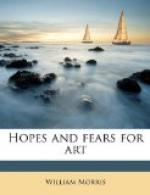All art starts from this simplicity; and the higher the art rises, the greater the simplicity. I have been speaking of the fittings of a dwelling-house—a place in which we eat and drink, and pass familiar hours; but when you come to places which people want to make more specially beautiful because of the solemnity or dignity of their uses, they will be simpler still, and have little in them save the bare walls made as beautiful as may be. St. Mark’s at Venice has very little furniture in it, much less than most Roman Catholic churches: its lovely and stately mother St. Sophia of Constantinople had less still, even when it was a Christian church: but we need not go either to Venice or Stamboul to take note of that: go into one of our own mighty Gothic naves (do any of you remember the first time you did so?) and note how the huge free space satisfies and elevates you, even now when window and wall are stripped of ornament: then think of the meaning of simplicity, and absence of encumbering gew-gaws.
Now after all, for us who are learning art, it is not far to seek what is the surest way to further it; that which most breeds art is art; every piece of work that we do which is well done, is so much help to the cause; every piece of pretence and half-heartedness is so much hurt to it. Most of you who take to the practice of art can find out in no very long time whether you have any gifts for it or not: if you have not, throw the thing up, or you will have a wretched time of it yourselves, and will be damaging the cause by laborious pretence: but if you have gifts of any kind, you are happy indeed beyond most men; for your pleasure is always with you, nor can you be intemperate in the enjoyment of it, and as you use it, it does not lessen, but grows: if you are by chance weary of it at night, you get up in the morning eager for it; or if perhaps in the morning it seems folly to you for a while, yet presently, when your hand has been moving a little in its wonted way, fresh hope has sprung up beneath it and you are happy again. While others are getting through the day like plants thrust into the earth, which cannot turn this way or that but as the wind blows them, you know what you want, and your will is on the alert to find it, and you, whatever happens, whether it be joy or grief, are at least alive.
Now when I spoke to you last year, after I had sat down I was half afraid that I had on some points said too much, that I had spoken too bitterly in my eagerness; that a rash word might have discouraged some of you; I was very far from meaning that: what I wanted to do, what I want to do to-night is to put definitely before you a cause for which to strive.
That cause is the Democracy of Art, the ennobling of daily and common work, which will one day put hope and pleasure in the place of fear and pain, as the forces which move men to labour and keep the world a-going.
If I have enlisted any one in that cause, rash as my words may have been, or feeble as they may have been, they have done more good than harm; nor do I believe that any words of mine can discourage any who have joined that cause or are ready to do so: their way is too clear before them for that, and every one of us can help the cause whether he be great or little.




